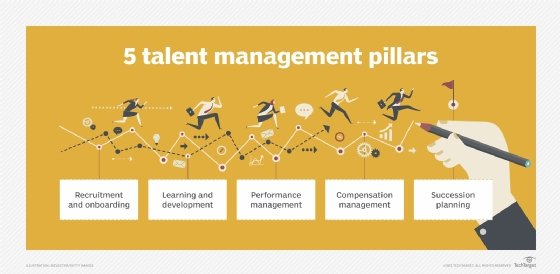
sommai - Fotolia
A definitive list of talent management software features
Go beyond the marketing hype, and dig beneath the surface to identify the not-so-obvious features you need to assemble a talent management suite that can grow with your company.
Over the past several years, talent management has quickly transformed from a subset of human capital management skills associated with compensation and training to its own full-fledged suite of capabilities that includes cradle-to-grave support of each employee's journey through the company. As talent management has become a strategic differentiator in organizations and an increasingly complex set of proficiencies, potential buyers need to learn to identify key talent management software features and align them with strategic HR goals.
But how should talent management software features be evaluated? What are the key traits your company should look for as it pursues talent management technology? And which of these functions might already be in your organization, either through an existing HR system or through collaborative technologies that are managed by IT rather than HR? This list of talent management software features and guidelines can help.
Determine requirements for talent management software
Before defining key talent management software features, there are a few high-level capabilities to keep in mind. First, if your organization is seeking highly specialized tools for any part of talent management, it may need to put together a best-in-breed selection of vendors to bring specialized sales compensation, video interviewing and predictive analytics models together. In this case, application integration is vitally important. It's also essential if you want to continue using existing technology, such as an applicant tracking system.
Second, a new set of technologies have redefined software platforms: social, mobile, analytics and cloud. When evaluating talent management software features, you should ask the following questions:
How social is it? Does it enable collaboration, and can it track and integrate social networks and preferences?
How mobile is it? Is self-service available via the mobile web or as a mobile app? Is the software supported across multiple mobile OSes and form factors? Is the mobile version's functionality comparable to that of a desktop or laptop version? Is mobile security on par with laptop security?
How analytical is it? Can you pull the data into your own data discovery or business intelligence tool? Can you create dashboards and out-of-the-box reports that will meet both your own and your executive stakeholder's needs?
How cloud-enabled is it? Is it hosted, or is it multi-tenant SaaS? Is there a business continuity option that includes multiple locations? Can it be offered on a hybrid cloud basis, where both on-premises and hosted environments are simultaneously hosted? Are its cloud options secure and compliant?
In general, talent management suites include the following capabilities:
- learning management and development;
- recruiting and talent acquisition;
- corporate collaboration;
- workforce planning;
- compensation management;
- performance management; and
- succession planning.

Many of these might seem like they are already covered within standard human resource information systems (HRISes), which are sometimes called human resource management systems (HRMSes). But the devil is in the details. Of all of the functions listed above, learning is typically the key driver for new talent management system purchases. Because of this, companies should start by aligning learning with the existing need for corporate education, including education delivery, compliance tracking and linkages between education and ongoing performance.
Typically, companies purchase talent management suites because they have outgrown the standard tracking and reporting functions in their HRMS learning modules. For instance, an HRMS might track basic attendance information and scores for a continuing education course, but it often lacks the video and document management capabilities needed to support the course on an ongoing basis. When considering learning management and career development modules, buyers often compare their features based on requirements that vary widely based on geography, vertical industry and level of ongoing education required. These features include the following:
- event management;
- course development;
- content and document management integration; and
- access to e-learning providers, virtual classrooms, social networking and ongoing skill development and education tracking.
Checklist of talent management software features
The remaining modules are less likely to drive new talent management system purchases as standalone options, although potential customers typically start with two or three of the core modules bulleted above with the intention of building out a suite.
In general, here are the key differentiating traits you should look for in each module:
Recruiting and talent acquisition: For talent acquisition, focus on skills assessments at the time of interview and social outreach. Determining applicant skills before the time of hire, as opposed to simply trusting a pat interview answer or resume entry, will result in stronger employees. Likewise, if your company can use trusted social networks and collect social referrals through its recruiting technology, it will be easier to find qualified candidates.
Corporate collaboration: Social collaboration functions can seem like duplicates of existing social platforms, such as Yammer and Jive, or communications systems, such as Cisco and Avaya. Buyers should focus on the differentiation between collaboration tools within talent management suites -- including features for measuring and improving employee engagement -- compared to existing in-house systems.
Compensation management: Compensation management is becoming increasingly difficult as variable compensation, contingent labor and alternative compensation methods become increasingly popular both in sales and in other customer-facing roles. To fully support these use cases, an organization might need to engage a vendor that specifically supports sales performance management to gain the flexibility needed to manage compensation effectively.
Performance management: Performance management can run the gamut from basic goal management and the tracking of annual reviews to near-continuous coaching that provides contextual reinforcement from social and gamification-related communications. Depending on your company's desired model for tracking performance, you might need to customize performance management software to track desired objectives and to integrate collected data with corporate performance management systems and other enterprise data sources.
Succession management: Make sure that your succession module provides an integrated view of both internal and external talent associated with a specific role. If your organization internally trains and prepares heirs apparent for specific roles, ensure that these future leaders are gaining the necessary skills to fill the position successfully and that their skills would pass muster if the role were being offered to an external employee. Ideally, succession planning should happen at both executive and operational levels, as no task in the company should face a permanent bottleneck if any employee leaves for any reason.
With these features in mind, your company can enter the talent management system buying process prepared to make a strategic long-term decision based on the needs of your organization and its existing technology infrastructure.






